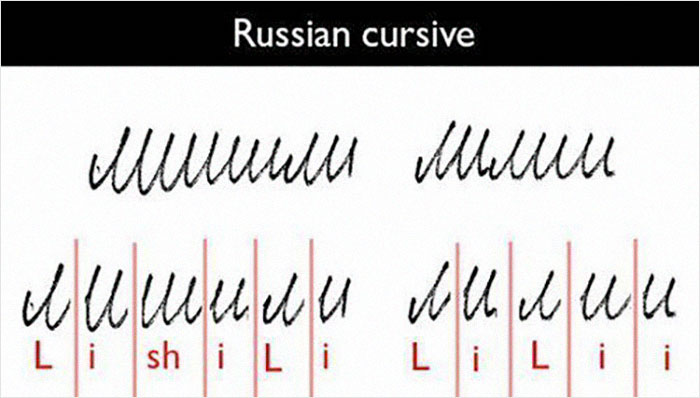Alt text:
𝓘 𝓽𝓱𝓲𝓷𝓴 𝓬𝓪𝓹𝓲𝓽𝓪𝓵 𝓛 𝓲𝓼 𝓹𝓻𝓸𝓫𝓪𝓫𝓵𝔂 𝓽𝓱𝓮 𝓶𝓸𝓼𝓽 𝓯𝓾𝓷 𝓽𝓸 𝔀𝓻𝓲𝓽𝓮, 𝓽𝓱𝓸𝓾𝓰𝓱 𝓵𝓸𝔀𝓮𝓻𝓬𝓪𝓼𝓮 𝓺 𝓲𝓼 𝓪𝓵𝓼𝓸 𝓪 𝓼𝓽𝓻𝓸𝓷𝓰 𝓬𝓸𝓷𝓽𝓮𝓷𝓭𝓮𝓻.
My cursive looks like a 10yr old wrote it, which is about the last time I actually wrote in cursive
I hate that they still teach it in schools. It means that for about 3-4 years per child, you get birthday and Christmas cards and you can’t read them.
It’s not noticeably faster and it’s certainly not neater. Just let it die.
It is neater and faster but people cannot read it nor reciprocate. It used to be more or less universal. I like it and use it, but won’t if what’s being written is for the public.
When I was young my teacher said “If you want to be taken seriously you must use cursive!” She also said I’d never have a calculator in my pocket when I needed it, so there’s that.
Also writing speed doesn’t really matter anymore. Most situations where writing speed used to matter now needs typing speed instead.
I don’t buy this. I take notes on paper all the time, what am I going to have my laptop or phone in my face during every conversation?
What are you doing that having a pen and paper is normal but your phone or laptop isn’t?
I work in habitat restoration. I spend a lot of time outdoors, but most of my notes are just from my normal meetings. If I’m on my phone taking notes, I have to stare down at my phone and it takes me out of the meeting. I have ADHD and find my phone very distracting. But I can write quick notes on paper without having my head down.
I also just prefer physical notes. I have tried everything under the sun with digital note-taking, but nothing beats the flexibility and reliability of pen and paper. I have a great binder-based note-organization system.
I am honestly shocked that so many people NEVER use pen and paper notes? It is very normal in my field.
I find this fascinating. Props to you, of course.
Speaking for myself, my handwriting is far from elegant. In university (40+ years ago) I developed a sort of mashup of cursive and printing, since speed of transcription was fairly typical.
I adore the look of top tier handwriting. I even got into calligraphy when I was in HS.
Since my career has taken me deep into the world of tech, I’ve become twitchy at the possibility of a single point of failure, ie, one copy of something is equivalent to no copies of something, 2 copies of something is equivalent to 1 copy, etc.
As such, I’ll take casual note (eg, my to do list for my ADHD) using Google Keep, so that I can access it and update it from my phone or one of my laptops. For the grocery list, it’s Alexa. For professional notes, it’s a combination of Obsidian and Syncthing.
Speaking of Obsidian, I first learned of it while watching a video of anPhD student describing her massive manual note taking system, following a particular system manually, and then discovering Obsidian.
In your case, yeah, I see no reason to change. It works for you.
Yeah, paper note-taking does mean scanning right away when you’re back in the office. But the reality of field work is that you might lose the data if you took them on a tablet, too. I’ve worked jobs where there was no service until we get into the office, so the data just lives on the device until it is uploaded.
I am using Obsidian for a particular project, I’m using it to organize a history research project I’m working on! I think it’s a cool tool, I would just go crazy if I had everything organized on my computer. I end up hyperfocusing more on the organizing system itself, or get distracted on the computer/phone… and the physical notes I can make cute and aesthetic much more easily which makes me feel warmly about my to-dos. I tried to do a digital PDF notebook with hyperlinks and everything, but I just felt like I was spending too much time fiddling around with on my note-taking and organization.
Paper stationary is a lot more popular in Germany and Japan, oddly enough. A lot of jetpens products come from those countries … the most sought after notebooks are Japanese and Germans have great pens.
It’s definitely not neater for lefties like me who smear our script as we write.
However, OCR input tech on phones and tablets are better at reading cursive than block print. Curiously, my grandson’s curriculum in the Solano County School District dropped cursive writing and then picked it up again.
I heard more than a few US states decided to expend a law on requiring it because taught, your grandson might be a victim of such a policy.
deleted by creator
deleted by creator
Lowercase m, n, u, v, and w are confusing as shit when placed next to or near each other.

Try Cyrillic cursive.
I remember coming across a similar comment chain, and someone brought out cursive Hanzi, and everyone lost their minds.

It’s gets so much worse when you use russian cursive.
how bad is russian doctor handwriting?
Not russian doctor handwriting, Russian cursive

That cant be real ahah thats impossible to decipher
Oh it’s real, and just to rub salt in a wound, here’s a doctor using russian cursive on an entire form, or at the very least some kind of student, courtesy of Wikipedia

nothing in this life feels better than writing a cursive f. i put my whole arm into it. those things are the highlights of anything i write
I am very proud of my F/f, too. I do them beautifully because it is the first letter of my name.
Serious question for people younger than me: How did you come up with a signature if you didn’t learn cursive?
Wait your signature is supposed to just be your name in cursive? But then wouldn’t that defeat the point? I thought in the olden days it was supposed to be like a proof that you were the right person since you knew how your signature was written.
Anyways, for my signature I just kinda designed it. It was ages ago so I forgot my process, but it was deliberate and I remember making a whole bunch of sketches before finding one I liked. And since then I’ve incrementally improved it.
Although cursive has a unified design, everyone writes cursive a little differently. The idea is that cursive is designed to write whole words in a single stroke. The concept of a secure signature in cursive is that the more work a single stroke is, the more uniquely a person writes it.
That is to say, even though you may have the same name as someone else, it’s extremely unlikely that a person can copy your nuances precisely enough to forge your signature on the fly. It isn’t a perfect system, but it’s easy enough to verify a signature that people could do it before technology was around to aid that process.
That concept is also why they say the actual design of your signature is less important than the consistency of doing it the same every time.









